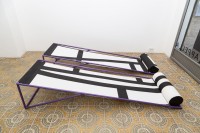Hella Gerlach
PARADISE GARAGE
29 Ottobre 2015 – 13 Febbraio 2016
Antonio Luigi Cremona was a 19th century Italian mathematician who developed what became known widely as the Cremona plan. This plan equipped architects with a mathematical system to calculate the ideal relationship between force and gravity necessary for the construction of timber frame architecture of the sort used in traditional German houses (Fachwerk). Cremona demonstrated how the push and pull of each individual timber beam could be channeled into a balanced system that derived strength from an equal distribution of tension over the total number of interlocking, supple joints. In her paradise garage Hella Gerlach takes Cremona’s system and the timber frame buildings of her native region in Germany as a point of departure from which she literally extends new lines of perspective. The exhibition’s title itself references another force field, the house club Paradise Garage, which was a fixture of alternative night life and music in downtown Manhattan during the late 1970s and 80s. Through the idea of physical connection and equilibrium, Gerlach links the dance club where bodies collected into a kind of flexible social sculpture to the timber frame houses, which Cremona proposed could be best designed around principles of flexibility and interconnectivity.
Both fachwerk house and club give shelter to socio-political and physical entities, Gerlach suggests, in which parts come together to form a dynamic whole that develops inside of a frame work, but pushes against and extends this frame at the same time. In this sense, the connections that Gerlach makes reveal themselves as elastic: elements conjoined around architectural nodes, which balance the pressure of one element against the calculated release of pressure on another. In this manner, one could say that loose joints become both the integral construction tools and the conceptual apparatus in paradise garage for a sculptural vocabulary that invites connections between disparate elements and asks the viewer’s body and mind to bend flexibly to open up new points of view. Deck chairs become walls, or bars from which to dangle and turn upside down. Lines extend and recede as physical pulleys that can be drawn from one point to another. Ice cream is baked instead of frozen. Awnings stretch inward instead of outward. Rum raisons connect in chains to cucumbers. These links are elastic like Cremona’s architectural nodes. One element stands in a stretchy dialogue with another, pulling together and pressing apart so that strength manifests itself as flexibility and pliancy generates force.
Sasha Rossman
Hella Gerlach (1977, Germany) lives and works in Berlin. She studied experimental sculpture at the Art Academy Dusseldorf with Rosemarie Trockel, art history at the University of Cologne and design at the Cologne International School of Design. In 2009 she initiated the still ongoing project “Die Fuge” (The Fugue), a moving space for dialogue, experiments and presentations in collaboration with other artists and guests. Hella Gerlach is an editorial member of the magazine SKULPI (2010), initiator of the project WHEELY (2005-2007) and curator of Simultanhalle, Cologne (2003-2006).
KubaParis
Art Viewer
A Raw Tip
Artforum
Corriere Del Mezzogiorno


















